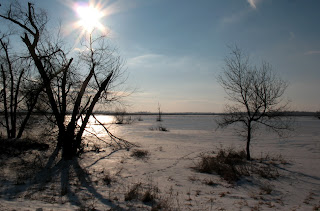It was in the lower forties, but the wind made it feel much colder. ITs force never failed. My mother and I drove the first third of the refuge before we found anything exciting. Some eagles- juvi's and adults took turns flying against the wind. They did not make too much progress and most returned to a muskrat mound or the ice soon after taking flight.

I spotted the first group of swans far in the distance- 13 of them! They all appeared to be trumpeter swans. A bit further we spotted th rest of them on the ice and in the water. There were many and they were all the same distance from the road as the first group. Closer to the car- only about 100yrds- a smaller duck paced the perimeter of a tiny puddle of open water. His lake was 10 feet in diameter- an island in an ocean of ice- The bird was dark and oddly-shaped. It had a small white spot on his cheak and a white neck and breast. "A Bufflehead or Goldeneye" I identified, honestly not knowing the difference- When I gained access to a field guide I decided that the bird we saw was defenitaly a Common Goldeneye. The pattern of the wings and size were the difference. When my attention turned back to the swans in the distance, I noticed that they were standing and swimming amongst a thinck crown of smaller dark birds. Most of them were Canada Geese and Mallards. The swans were too many to count- but they were giant when they stood next to the geese. Several had the darker necks and two had green bands. I searched the group for the smaller Tundra Swan, but never noticed one.
A small goup of eagles stood on the bare ice behond the swarm of waterfowl. They stared, and probably dreweled, but I could not see any strings of saliva from their beaks.
My mother spotted a pair of great blue herons that I could not. She gave me the Nocs and directions. I found the birds, but they were not herons. The two were tall with a more round body- not much of a visible tail. I saw a hint of red and identified them as Sandhill Cranes. In disbalief, she took the binoculars from me and confirmed my id- she said that when one lifted its head she saw the distinct profile of a crane. I have never seen them this fas east, and never this far north this late in winter! I suspect that they had come in with the geese and stayed with the flock. EXCITING!!
 The rest of the drive was about scenery and critters. The icey landscape reflected the sun in ways it does only in the mountains and far north. Most of the wetland was frozen, and any plants were pressed to the ground by the heavy snow. On the long, strait stretch of the road that is under the canopy of trees there was an opossum. He edged the side of the road in the snow. I jumped out of the van and joged to intercept him for a photo on the other side of an old tree. I waited several seconds, but he never showed himself. My mother told me to look in the tree- above me. I circled, but never found him... he had *poofed!*
The rest of the drive was about scenery and critters. The icey landscape reflected the sun in ways it does only in the mountains and far north. Most of the wetland was frozen, and any plants were pressed to the ground by the heavy snow. On the long, strait stretch of the road that is under the canopy of trees there was an opossum. He edged the side of the road in the snow. I jumped out of the van and joged to intercept him for a photo on the other side of an old tree. I waited several seconds, but he never showed himself. My mother told me to look in the tree- above me. I circled, but never found him... he had *poofed!*

CAT WALK!
Took the hike to the left of the center- at the far end of the parking lot. Followed it in the thick snow until it was no more. The surface of the snow had melted with the day and then froze again- it was about 4:30 and the sun was getting low. Each step was acompanied by a crack of the ice, a crunch of the snow, and another crack as my foot broke the surface upon exiting. My poor choice of footwear left me with some pain and the sensation of walking on my ankles.


2 comments:
I like the B & W version! Great descriptions of your day at Squaw Creek. So glad you got to see the Sandhill Cranes!
I love them both! But I think the B&W one is most dramatic of the two.
Post a Comment